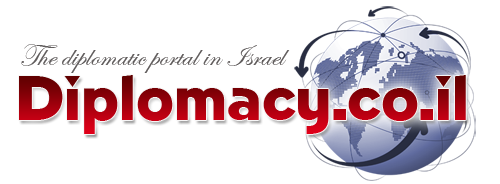Art & Culture
- Details
- Written by Silvia G. Golan

Tel Aviv Museum of Art, Design and Architecture Department present NFT > ONE OF A KINDS
Dates: Opening: July 6, 2022 Closing: December 3, 2022
Location:
Safra Foyer, Herta and Paul Amir Building
Exhibition text (short):
The Museum presents a unique project of its kind in the world, focusing on the phenomenon of NFTs – Non-Fungible Tokens, or digital files registered by an e-commerce network (blockchain) whose technology enables reliable identification of the source, thereby rendering it unique. In March 2021, Christie’s sold the work Everydays by American digital artist Bepple for a record $69.3 million. It is the most expensive digital work sold to date, and the first to NFT enter public consciousness as such. Forty NFT works by local and international artists are displayed in the entrance lobby of the Amir Building. The encounter with the virtual world within the real space offers visitors the experience of being in both spaces at once, while moving between them.
On March 11, 2021, an extraordinary event took place in the art world, when Christie’s Auction House sold the digital work All Days: The First 5000 Days, by the American digital artist known as Beeple, for a record price of $69.3 million. The most expensive digital work ever sold (to date), it introduced the new term NFT into the public consciousness.
At that moment, a new arena opened up, raising fundamental questions about value, the essence of copy and original, and thoughts on quality and quantity. It also challenges the role of the museum in new ways. For example, the profile of NFT creators is extremely diverse: some choose an invented identity, and in other instances the creator is in a sense a programmed algorithm, whereby the artwork is in constant flux. Anyone, it seems, can take part. All that is needed is a new type of digital certificate that regulates and defines the ownership of the original work. This certificate does not forget the work’s original creators, leaving them a share of every sale, which is predetermined by the creators themselves.
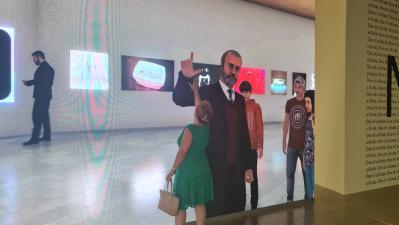
In the current exhibition, we seek to present this unique cultural and technological phenomenon as it continues to evolve. To this end, we have chosen a public space that serves as a foyer rather than an “official” gallery in the Museum, in which we created a world whose reality is ambiguous: the boundaries of the physical foyer are expanded and replicated in a virtual space, while rooting it in familiar features of the actual surrounding architecture.
Feel free to chat with TAMA – a bot (smart virtual character) developed especially for this project – and ask her almost anything you wish about NFT. The virtual exhibition in front of you explores forty different NFT works by a wide range of creators. In preparation for the exhibition, we issued an international open call, inviting creators and owners of NFTs to submit proposals of artworks. Hundreds responded, and a professional committee selected the collection on view. This curated selection offers a glimpse into the fascinating activity that is taking place in this arena – a first introduction to new forms of creativity.
List of creators:
Future Positive )Nir Goeta & Rotem Goeta( - Tomer Mor Joseph - Peter Spacey & TEC (Omer Luz, Dylan Roscover and Anita Kucharczyk - Avraham Pesso - Ofir Liberman - Eyal Yehowa Gruss - Khen Shish - Gilad Edelstein - Deborah Fischer, Yarden Colsey, Ofer Kantor - Doron Golan - Daria Durand - Angelika Sher - Yambo & Somei Sun - Kfir Ziv X NFT Tel Aviv - Lidar Farjun - Moran Victoria Sabbag - Matty Mariansky - Nitzan David Hamerman – Kafein - Ron Guetta - Noa Gana and Gal Kuflik - Ran Slavin - The Knocks – Pak – DEDE - Itamar Stamler, Lior Zalmanson - Geldz, ZOZ, and GURION - Sarah Meyohas - Rosie Gibbens - Tamar Karavan - Chat Des Rues - Udi Cassirer - Scan The City - Smadar Lomnitz - Cookie Moon - Thomas Paquet - Eduardo Kac - Desperate Ape Wives - Bored Ape Yacht Club – CryptoPunks - LIŔONA
TAMA - smart virtual:
Tama is a smart virtual character developed for the Tel Aviv Museum by the Advanced Reality Lab (ARL) at Reichman University. Tama's development process included script writing, recording, character design, facial animations, creating a 'smart' development tree, and of course - integrating “artificial intelligence” using deep learning NLP models, which allow the user to naturally interact with her. In order to make Tama smart, she went through a process of learning and practicing all the possible questions, phrases, and utterances in the conversation domain. The more visitors talk to Tama, the smarter she will be!
The Advanced Reality Lab (ARL), Reichman University
ARL is a multidisciplinary laboratory that studies the process of human-machine confluence taking place in recent decades. Our current focus is on the development of virtual humans in virtual reality; this encompasses a wide range of technological and design challenges, and we focus on generative machine learning for verbal and non-verbal communication. In addition, we study the impact of such virtual humans on the individual (in collaboration with researchers in the fields of psychology) and society (with the help of computer simulations). Finally, the laboratory deals with the applications of these studies to basic and applied research in clinical and social psychology.
Collaboration with Sandmilk:
Sandmilk is a leading platform for NFT creators that enables digital creators to present their work in the new medium and develop new options with a dedicated audience. In addition, the company makes the trading experience accessible when it eliminates the need for a personal digital wallet. As part of the collaboration with the Tel Aviv Museum of Art, approximately 5,000 unique NFT works created especially for the exhibition will be distributed to the first 5,000 visitors.
Exhibition team:
Curator: Maya Vinitsky
Associate curator: Yonni Avidan
Assistance curator: Michal Derhy-Vieman
Exhibition design: Alexey Shamovsky, KIN SKY STUDIO
Graphic design: Noa Schwartz
Nominator team for NFT artworks: Dr. Liat Lavi, Dr. Maya Shmailov, Roee Bigger, Ben Benhorin, Tal Broitman, Ruti Director, Mira Lapidot, Ilai Dgani, Daniel Krol
Virtual world construction and activation: Arium, New York
Hebrew editing: Dafnit Moskovich
English: Mor Ilan
Arabic translation: Dr. Ruba Simaan
Arabic editing: Nabil Armaly
Scientific consultation: Matty Mariansky
Cinematic consultant: Ohad Milstein
Media consultant: Adi Peltinov
Media mounting: Multifect Ltd.
Printing: Kzat Acheret Design and Sign
TAMA specifications and development:
Project Management, Product & Experience Designer: Maya Shekel, Reichman University
Software & Unity Development: Niv Rosnovsky, Reichman University
Director of the ARL Lab, Consulting and Guidance: Prof. Doron Friedman, Reichman University
Content writer and editor: Sigal Siryus
Chatbot content design: Kinneret Yifrah, Amir Gewurtz, and Stav Moran Leshem
Voice over: Mira Awad
The exhibition was possible thanks to the support of DANAE
Images credit: Alexey Shamovsky, KIN SKY STUDIO
Photos credit Silvia G Golan
More Pics at Facebook Diplomacy Israel / Israel Diplo / Silvia G Golan
|
מבט מתוך חלל התערוכה הווירטואלית – NFT > ONE OF A KINDS |
|
מבט מתוך חלל התערוכה הווירטואלית – NFT > ONE OF A KINDS |
|
Tama is a smart virtual character developed for the Tel Aviv Museum by the Advanced Reality Lab (ARL) at Reichman University |
- Details
- Written by Silvia G. Golan

After the first and most successful months of operation of The David Kempinski Tel Aviv hotel, the ribbon cutting ceremony was held on Monday, July 4, to celebrate the official launch of the 80th hotel of the European luxury brand and its first hotel in Israel.
The launch event was attended by the Minister of Tourism, Mr. Yoel Razvozov, the Chief Executive Officer Kempinski Hotels and Chairman of the Management Board , Mr. Bernold Schroeder, the developer and hotel owner, Mr. Henry Taic, the Mayor of Tel Aviv-Jaffa, Mr. Ron Huldai, and Tzipi Brand, the Deputy Mayor and Portfolio Holder.
The event was opened by the President of the State of Israel, Mr. Isaac Herzog, who delivered a recorded speech and spoke about the return of inbound tourism to Israel and the importance of continuing investments in the hotel sector. The President congratulated the developer Henry Taic, the hotel owner, on the expression of trust in Tel Aviv.
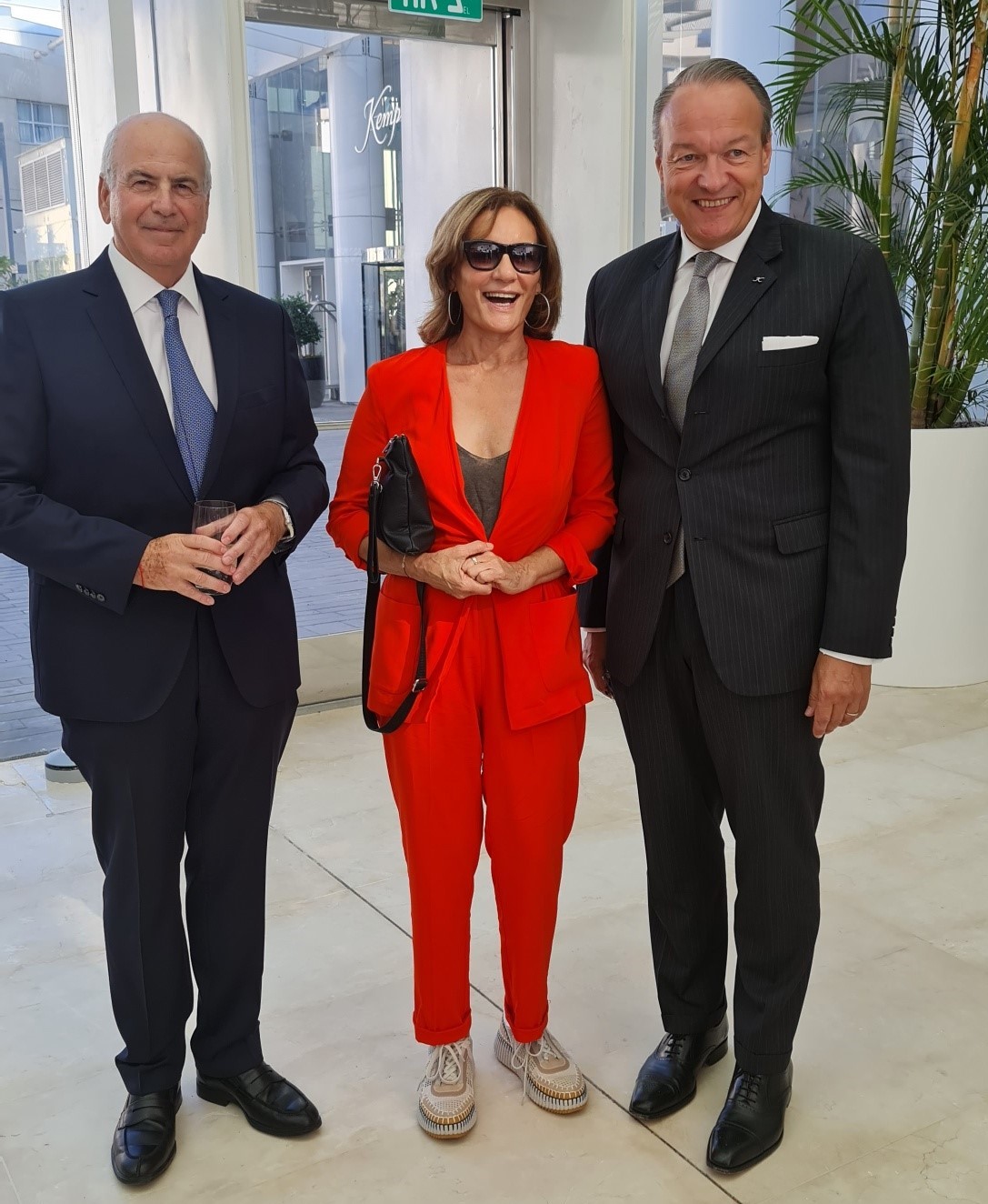
Mr. Bernold Schroeder, CEO of Kempinski Hotels: "We are considering managing more hotels throughout Israel. We are very proud of this new jewel here in Tel Aviv, a city that has become a world-class brand and based on our experience it would make sense to management further properties in places like Jerusalem and other destinations and strengthen our presence in Israel."
Minister of Tourism Yoel Razvozov: "We are pleased that an international brand such as Kempinski has chosen Israel and there are plans to establish more hotels in Israel, which means that there is potential for luxury tourism, tourism that will bring in a lot of money and create many jobs. We welcome any such hotel."
Guy Klaiman, General Manager of The David Kempinski Tel Aviv hotel: "The hotel opened three months ago and as our CEO said, it is a great success. This is one of the best openings the brand has ever had. The brand itself promotes us a lot in all possible channels and that is part of what made us a very successful and popular hotel from the first day of our activity."
About Kempinski Hotels: Created in 1897, Kempinski Hotels is Europe’s oldest luxury hotel group. Kempinski’s rich heritage of impeccable personal service and superb hospitality is complemented by the exclusivity and individuality of its properties. Today the Kempinski Group operates 80 hotels and residences in 34 countries and currently has more than 26 prestigious projects under development around the globe. Each five-star hotel reflects the strength and success of the Kempinski brand without losing sight of its heritage; each one imbues the quality guests have come to expect from Kempinski while embracing the cultural traditions of its location. The portfolio comprises historic landmark properties, award-winning urban lifestyle hotels, outstanding resorts and prestigious residences. Kempinski is a founding member of the Global Hotel Alliance (GHA), the world’s largest alliance of independent hotel brands.
www.kempinski.com/en/tel-aviv/the-david-kempinski-tel-aviv
www.facebook.com/kempinski.telaviv
www.ghadiscovery.com
Pictured from right to left:
Tel Aviv-Jaffa Mayor Mr. Ron Huldai, Tzipi Brand Deputy Mayor and Holder of the Tourism and World World Portfolio, Mr. Bernold Schroeder, CEO of Kempinski Hotels , Minister of Tourism Mr. Yoel Razvozov, Yehudit and Henry Taic and Guy Kalman CEO of David Kempinski Hotel Tel Aviv
Photos credit Silvia G Golan
More Pics at Facebook Diplomacy Israel / Israel Diplo / Silvia g Golan
- Details
- Written by Silvia G. Golan
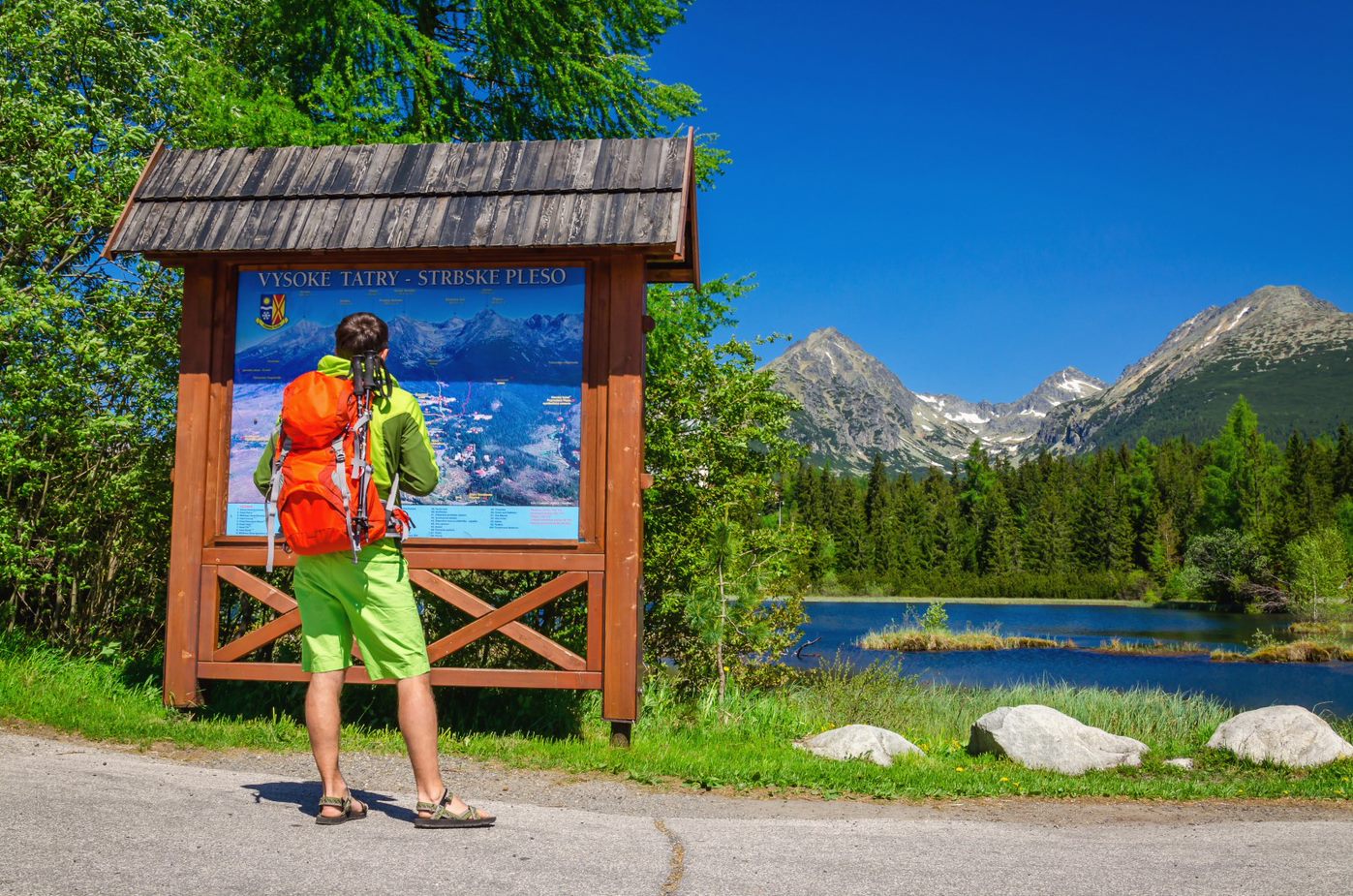
News in the tourism industry: On July 12, the Renaissance Hotel in Tel Aviv will host an international important tourism event of the Visegrad countries, led by Slovakia, to promote tourism in Central Europe.
The Visegrad Group was established in 1991 and is an alliance of four Central European countries: Slovakia, Hungary, the Czech Republic, and Poland. These countries have joined a joint tourism project under the slogan "Discover Central Europe".
The international event in Tel Aviv will be attended by several dozen tourism wholesalers, tour operators and senior travel stakeholders from the tourism industries of the four-member states of the Visegrad Group,
as well as senior tour operators & travel agents and travel stakeholders from Israel's tourism industry. The member states of the Visegrad Group share historical roots and cultural traditions.
It has luxurious spas, historic sites and cities, museums, stunning natural beauty, and UNESCO World Heritage Sites.
Treasures in the "heart of Europe", Slovakia is an ideal tourist destination thanks to its small area (about 49,000 square kilometers) and variety of tourist attractions. The High Tatras, spas, quality wineries, picturesque villages,
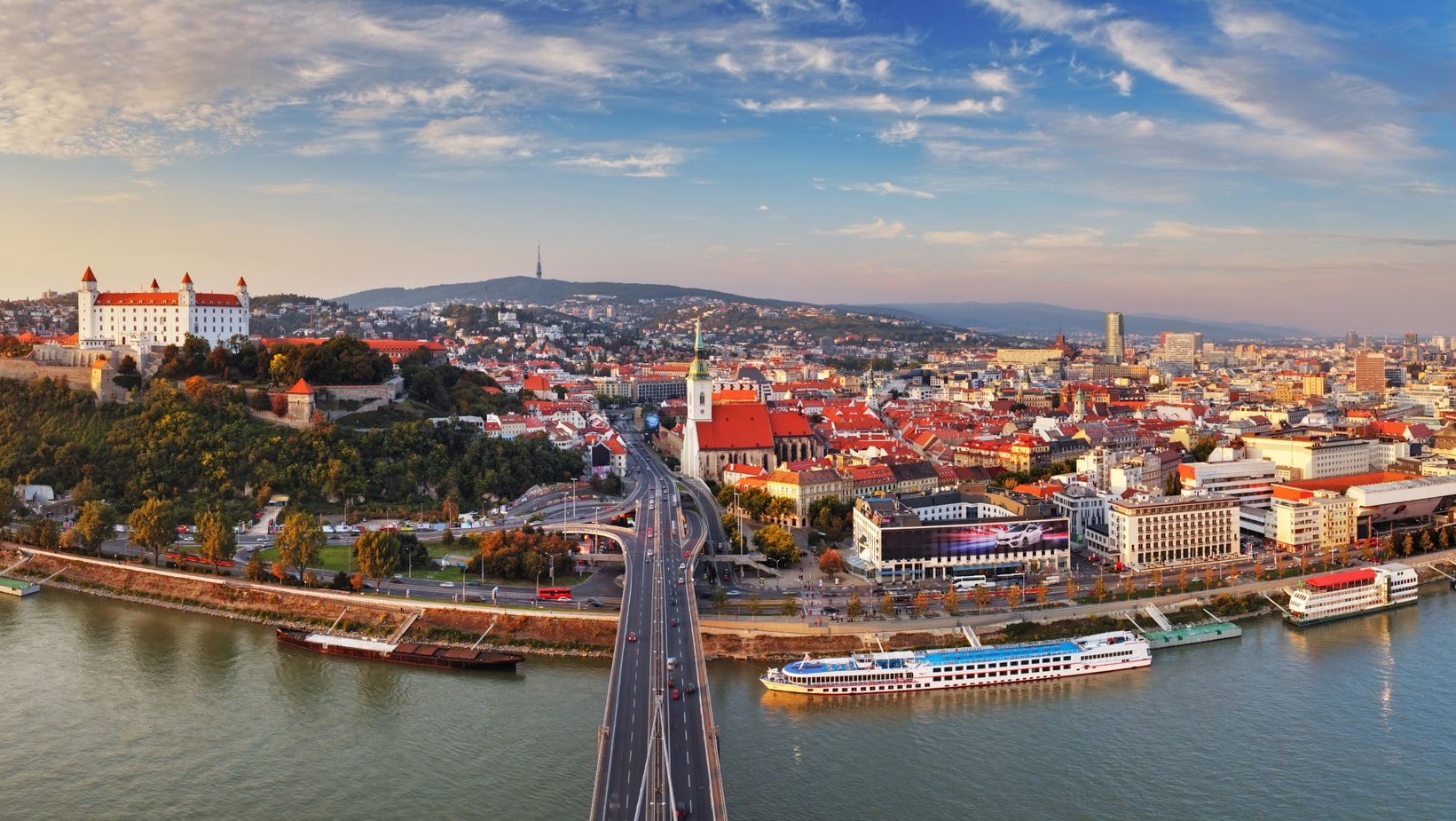
Sports & leisure, caves, ski resorts, hundreds of castles, towns where time stood still, museums, rich culture, and many UNESCO World Heritage Sites.
Natural treasures and historical monuments to rich folk culture and modern entertainment in the busy city streets. Organized groups, families, couples, and travelers will greatly enjoy discovering a new,
inexpensive, lush destination that suits every desire and style. Excellent holiday villages and a variety of attractions. 41 percent of Slovakia's territory is covered by forests. Slovakia joined the EU in 2004.
Slovakia, due to its location, is very accessible for tourist arrivals. It can be reached from the capital, Bratislava, Vienna, Prague, and even Budapest.
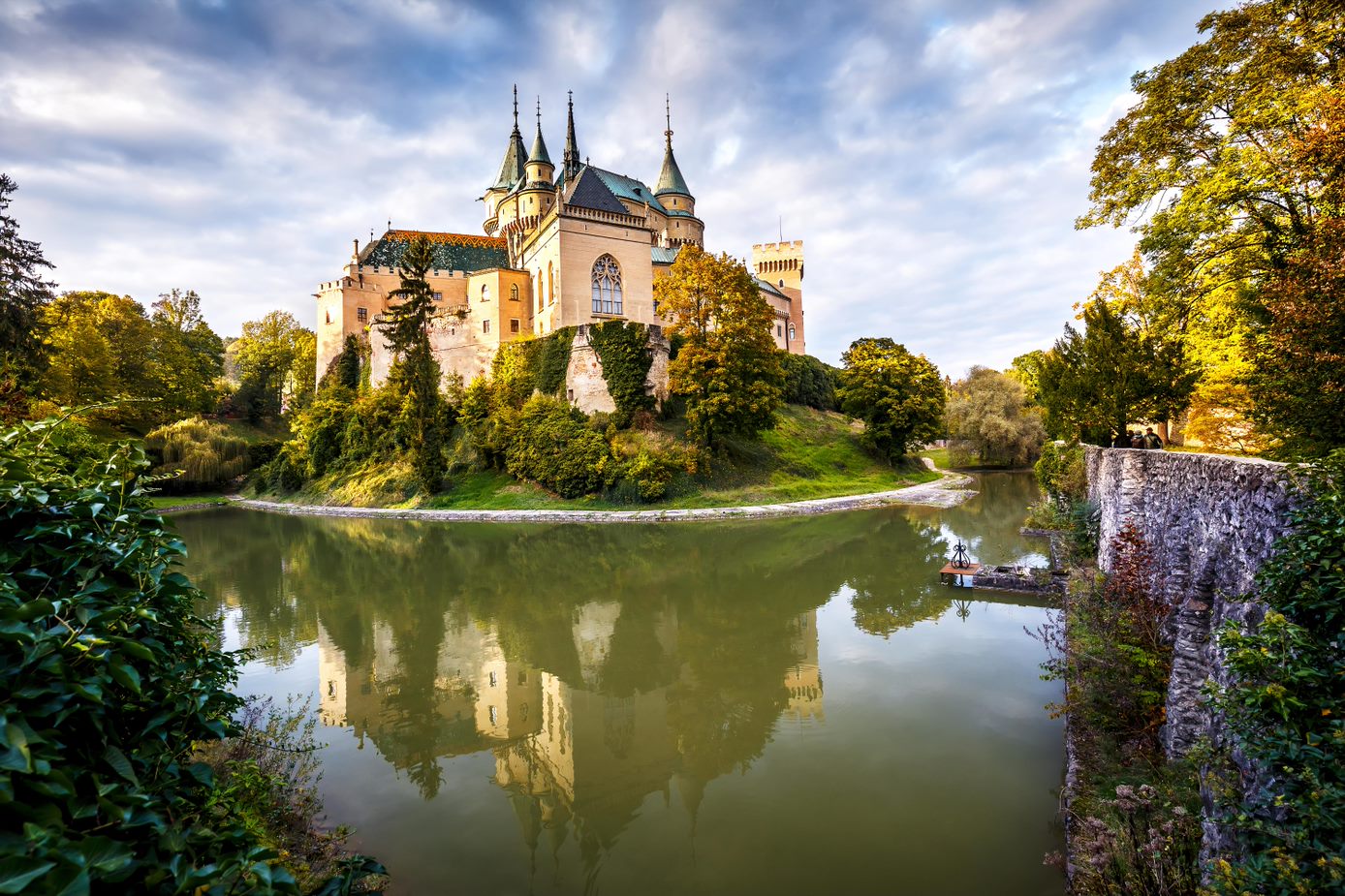
You can tour Slovakia by car or through the convenient train service. Tourist entry is also very simple. Corona restrictions have been lifted; there is no need to present a vaccine certificate, recovery certificate, or PCR test.
Photos courtesy: Slovakia travel
- Details
- Written by Silvia G. Golan
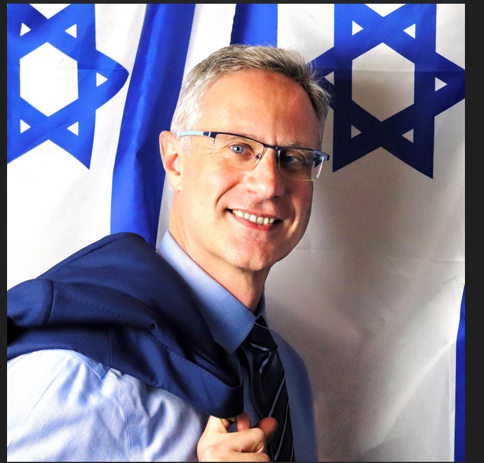
2022 Winner: Ariel Kahana (Yisrael Hayom)
Certificate of Merit: Yisrael Katzover (Hamodia)
Lifetime Achievement Award: Shlomo Nakdimon (Yedioth Ahronoth)
Performer Shuli Natan to receive Special Citation for Fostering Israel-Diaspora Relations through the Arts in Memory of Naomi Shemer; Special Guest: Lely Shemer
(Jerusalem, June 30, 2022)—Israel’s Ambassador to Ukraine Michael Brodsky will deliver the keynote address at the B’nai B’rith World Center-Jerusalem Award for Journalism Recognizing Excellence in Diaspora Reportage for 2022, entitled: "Not our war."
The ceremony will take place on Wednesday, July 6, at 7 p.m. (Israel Time) at the Konrad Adenauer Conference Center, Mishkenot Sha'ananim, Jerusalem (Light reception 18:30).
Ariel Kahana, political correspondent at Yisrael Hayom, will receive the award in recognition of a series of articles and interviews about anti-Semitism in the United States, Israel-Diaspora relations and the integrity of the relationship in the time of COVID-19.
Yisrael Katzover, a reporter and commentator at Hamodia, will receive a Certificate of Merit for a series of articles on Jewish communities in Arab countries.
Veteran Yedioth Ahronoth journalist Shlomo Nakdimon will receive a Lifetime Achievement Award for his extensive and exceptional body of work, which spans more than six decades and reflects a profound commitment to the essence of the award.
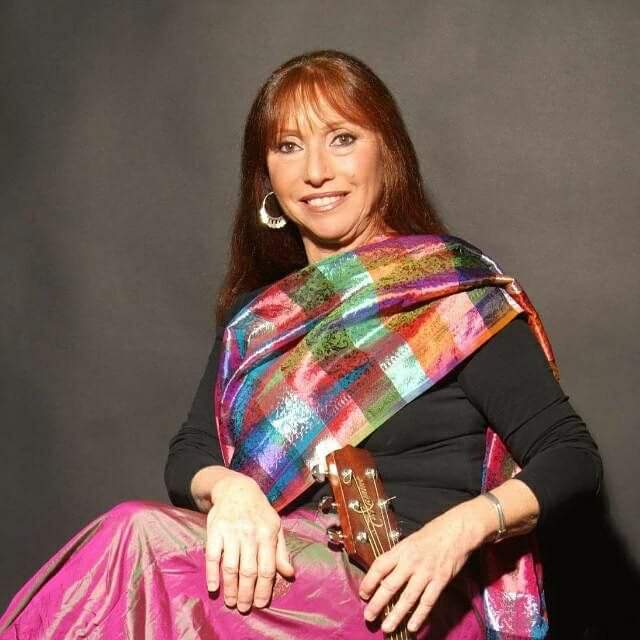
A special citation for Fostering Israel-Diaspora Relations through the Arts in Memory of Naomi Shemer will be presented to renowned singer, guitarist and composer Shuli Natan. The citation was established in 2014 and has been presented previously to Nurit Hirsh, David D’Or, Idan Raichel, David Broza, Yehoram Gaon, Shalva Band and Danny Sanderson. Shemer's daughter Lely will make a special presentation at the ceremony.
Since its establishment in 1992, the B’nai B’rith World Center Award for Journalism has recognized excellence in reporting on contemporary Diaspora Jewish communities and on the state of Israel-Diaspora relations in Israeli print, broadcast and online media. The award is widely recognized as the most prestigious prize in the Israeli media industry for Diaspora reportage and was established to help strengthen the relationship between Israel and the Diaspora. The award highlights the important contributions the media can make toward strengthening the relationship between Israel and world Jewry by encouraging quality reporting on Diaspora communities and Israel-Diaspora relations.
The distinguished members of the award jury are: Ya'akov Ahimeir, former editor and anchor, Israel Public Broadcasting Corporation, and Lifetime Achievement Award winner for 2016; Yehudith Auerbach, former head of the Department of Journalism and Communication Studies, Bar-Ilan University; Professor Emeritus Sergio DellaPergola, The Institute of Contemporary Jewry, Hebrew University; Sallai Meridor, former Israeli ambassador to the United States and former chairman of the Zionist Executive and Jewish Agency for Israel; Professor Gabriela Shalev, former Israeli ambassador to the United Nations; journalist Yair Sheleg; and Asher Weill, publisher and editor of “Ariel,” The Israel Review of Arts and Letters (1981-2003).
The award was established in memory of the late Wolf Matsdorf, editor of the World Center-Jerusalem’s journal “Leadership Briefing” and a journalist in Israel and Australia, and his wife, Hilda, a pioneer in social work in both Australia and Israel. The Lifetime Achievement Award is presented in memory of Luis and Trudi Schydlowsky, lifelong Zionists and leaders of the Peruvian Jewish Community, who published the Jewish Telegraphic Agency daily news bulletin in Peru for 30 years.
The award is made possible through donations from the Matsdorf family and B’nai B’rith World Center-Jerusalem board member Professor Daniel Schydlowsky.
B’nai B’rith International has advocated for global Jewry and championed the cause of human rights since 1843. B’nai B’rith is recognized as a vital voice in promoting Jewish unity and continuity, a staunch defender of the State of Israel, a tireless advocate on behalf of senior citizens and a leader in disaster relief. With a presence around the world, we are the Global Voice of the Jewish Community. Visit www.bnaibrith.org
Images courtesy:
Ambassador Brodsky and Ariel Kahana (B'nai B;rith world center).
Yisrael Katzover (GPO).
Shuli Natan (Ronen Ackerman).
- Details
- Written by Israel Antiquities Authority
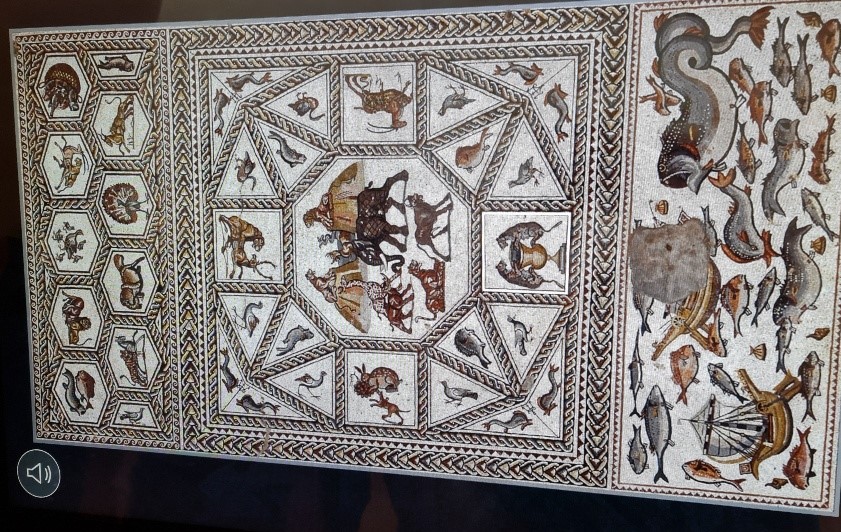
“Shelby White and Leon Levy Lod Mosaic Archaeological Center” Inaugurated Today in Lod
New visitors’ center to display a breathtaking mosaic, some 1,700 years old and among the world’s most beautiful
A dedication ceremony was held today, June 27, 2022, in the presence of Ms. Shelby White, Lod Mayor Adv. Yair Revivo, Israel Antiquities Authority Director-General Eli Eskozido, and numerous dignitaries.
After years on display in the world’s most important museums, including the Metropolitan Museum in New York, the Louvre in Paris, the Altes Museum in Berlin, the Hermitage in St. Petersburg, and others, the breathtaking Lod Mosaic – among the most beautiful discovered in Israel or anywhere in the world, and part of the floor of a late 3rd-early 4th-century mansion -- has returned to Lod and will be on public display, beginning this summer.
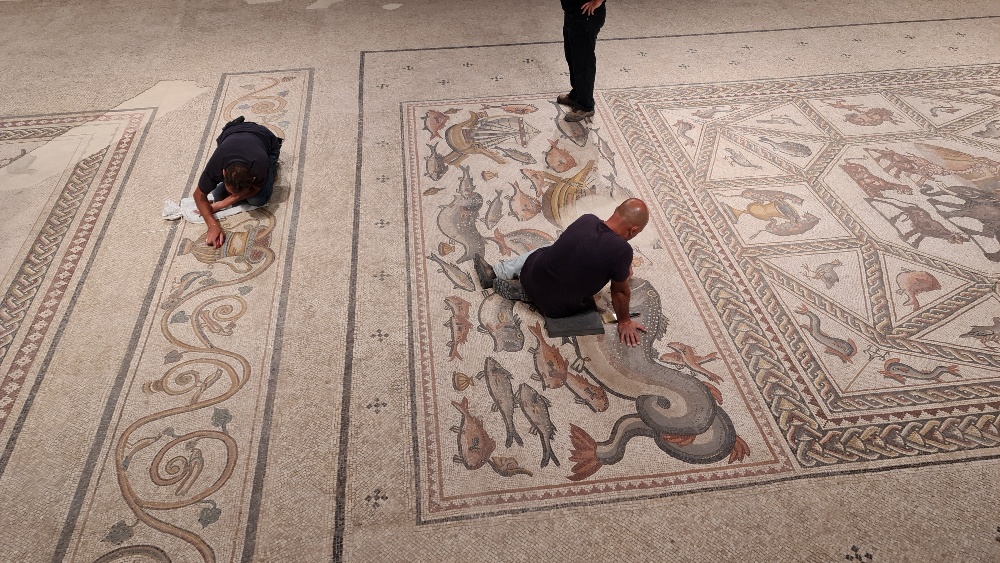
Today (Monday, June 27th), the Lod Municipality and the Israel Antiquities Authority inaugurated the Shelby White & Leon Levy Lod Mosaic Archaeological Center in the presence of donor Ms. Shelby White and representatives of the Leon Levy Foundation. Also participating in the event were senior representatives of the Antiquities Authority, the Ministry of Tourism, the Lod Municipality, and other dignitaries.
The Donor, Ms. Shelby White: “From the moment Leon and I saw this historic mosaic, we knew how important it was for the town of Lod and the world, and what it would do to make Lod a cultural center. I am thrilled to have the opportunity to be part of the restoration of the mosaic and the creation of this museum. Being here is a dream come true.”
Lod Mayor, Adv. Leon Revivo: “Some 26 years since it was discovered in 1996, we have reached this great day as we inaugurate the Shelby White & Leon Levy Lod Mosaic Archaeological Center, a source of local pride and a link to the timeless history of Lod – among the oldest cities in the world! Our dream for this city -- itself a mosaic of cultures -- is being realized today right before our eyes as we dedicate this most important museum, placing Lod on the world tourism map. We will enable people from around the country and the world to view this amazing treasure here in its original location, exactly where it was found. I want to thank Eli Eskozido, Director-General of the Antiquities Authority, his predecessors, Yehoshua (Shuka) Dorfman of Blessed Memory and Yisrael Hasson, and their staff for their tremendous dedication to this project, and for accompanying it throughout. And special thanks to our dear donor, Ms. Shelby White.”
Eli Eskozido, Director-General of the Israel Antiquities Authority: “Today, after years of effort, the final piece of the Lod Mosaic project has been put in place, with the dedication of this visitors’ center. This is a thrilling milestone for the Antiquities Authority, whose experts uncovered, preserved, and promoted the public display of this amazing mosaic. I wish to thank the Lod Municipality and the driving force behind this project – our donor Shelby White -- without whom the Lod Mosaic wouldn’t have returned home. There’s no place else in Israel that displays and tells the story of such a wonderful mosaic in such a special way!”
About the Mosaic
The Lod Mosaic was discovered in 1996 by Israel Antiquities archaeologist Miriam Avissar of Blessed Memory during an archaeological dig prior to the expansion of He’Chalutz Street. It stems from the Roman period – the end of the 3rd century or the beginning of the 4th century CE. Due to the lack of funds to preserve and develop the site for display, the mosaic was re-covered at the conclusion of the excavations. Then, in 2009, the Antiquities Authority, through the generosity of the Leon Levy Foundation and Shelby White, acquired funding for its renewed exposure and preservation and returned it to the site as an archaeological center open to the general public.
Unusual in its quality, construction, contents, and state of preservation, the mosaic once served as the foyer floor of a mansion in a wealthy Lod neighborhood from the Roman and Byzantine eras. It is about 17 meters long and about 9 meters wide and comprises colorful surfaces depicting fruits, mammals, birds, fish, flora, and even sailing vessels. Its design was influenced by that of North African mosaics. It’s interesting to note that, unlike other mosaics from that era, it includes no depictions of people. During the construction of the Mosaic Center, the Antiquities Authority discovered an additional colored mosaic that was part of the mansion’s courtyard. It was also included in the Center as part of the visitors’ experience.
The mosaic is located in northeastern Lod, adjacent to the Ginton Junction, making it easily accessible from Ben-Gurion airport and two major highways – Route 1 between Tel Aviv and Jerusalem, and Route 6, linking northern and southern Israel. Its proximity to national traffic arteries will make it a national attraction, placing it on the tourism map along with several of the city’s other historical sites.
The mosaic will be on display for the general public, enabling visitors to see and experience it from various angles while teaching them about Lod’s history, archaeology, and mosaic preservation as they enjoy its unique beauty. The new visitors’ center will strengthen the connection of Lod residents to their city’s important historical legacy. This is a unique project, a world-class exhibit of an important find in its original location within a modern structure that honors and recalls the mansion in which it once rested.
Credits:
Vision for the Visitors’ Center and mosaic preservation: Israel Antiquities Authority
Structural planning: Arch. Amit Nemlich – Nemlich Architects
Landscape planning: Arch. Orna Ben-Zioni, Arch. Idit Yisrael – Av Landscape Architecture
Content planning, execution, display and multimedia: Ha’Taasiya Content & Technological Design, Ltd.
Project management: Arch. Lilach Neumark – Ma’aseh Shimur
Supervision: Goni Engineering Ltd.
https://www.antiquities.org.il/article_eng.aspx?sec_id=25&subj_id=240&id=1574
Photos Silvia G Golan
More Pics at Facebook Diplomacy Israel / Israel Diplo / Silvia g Golan
